
AI CERTs
14 hours ago
AI Chat Ecosystem fuels next-gen group collaboration
Innovation around the AI Chat Ecosystem is accelerating. ChatGPT, Google Messages, and Microsoft Copilot now experiment with multi-user experiences. Consequently, the very idea of private chatbot sessions is fading. Professionals must understand how these shifts alter teamwork, policy, and market economics.
Market analysts forecast conversational platforms to surge from USD 17 billion in 2025 to nearly USD 50 billion by 2031. Moreover, vendors frame group collaboration as the next big differentiator. This article unpacks the major moves, highlights benefits, and flags governance risks.

Rapid Market Growth Signals
Research firm MarketsandMarkets projects a 19.6 percent CAGR for conversational tools. Furthermore, OpenAI already reports five million ChatGPT business users. In contrast, Google processes two billion suspicious messages monthly through on-device analysis.
The expanding AI Chat Ecosystem now spans consumer, enterprise, and telecom channels. Additionally, communication AI investments focus on privacy and real-time safety. Collaborative agents also gain traction as workplaces demand shared context.
- USD 17 billion market value in 2025
- USD 49.8 billion expected by 2031
- 23 percent chatbot CAGR through 2028
- Five million ChatGPT business seats
These figures confirm vendor urgency. Therefore, group features arrive amid fierce competition. The next section examines OpenAI’s strategy.
OpenAI Shared Projects Expansion
September 2025 brought Shared Projects to ChatGPT Business. Subsequently, connectors for Gmail, GitHub, and SharePoint linked project memory with real data. Teams now invite colleagues, set project-level instructions, and rely on collaborative agents for continuity.
Leaked screenshots in November teased a true group-chat interface. Invite links, custom bot behaviors, and reaction threads appeared. However, OpenAI has not published a rollout timetable. The AI Chat Ecosystem therefore watches closely.
Moreover, customers praise reduced context switching. Alyene Schneidewind of LogicMonitor calls connectors "catalysts" for transformation. Consequently, adoption looks poised to climb.
OpenAI’s moves illustrate how communication AI migrates from solo chat to multiplayer workspaces. Yet other giants are responding, as the following section shows.
Google Messages Group Evolution
Google’s June 2025 Android update added group icons, custom names, and AI photo edits inside RCS chats. Meanwhile, on-device scam detection flags fraudulent texts without cloud review. Dave Kleidermacher likens the threat landscape to an "epidemic" of scams.
Such privacy-first processing distinguishes Google within the AI Chat Ecosystem. Additionally, code hints reveal integration of Nano Banana image editing directly into Messages. Collaborative agents here focus on safety and personalization rather than enterprise reasoning.
Nevertheless, richer group tools may soon include assistant replies or automated summaries. The groundwork already exists. Therefore, corporate and consumer users should track Android feature drops closely.
Google’s emphasis on edge computing contrasts with Microsoft’s cloud strategy, explored next.
Microsoft And Rival Moves
Satya Nadella announced Copilot Groups in October 2025. Consequently, Microsoft 365 users can brainstorm with colleagues and an AI partner inside Teams. This launch underscores the competitive heat within communication AI.
Meta, WhatsApp, and Character.ai also trial group summarizers or multi-bot rooms. Moreover, smaller vendors like Rasa push open-source alternatives. Each player tries to own critical slices of the AI Chat Ecosystem.
In contrast to Google’s device focus, Microsoft centralizes intelligence in the cloud. Collaborative agents sync across SharePoint, Outlook, and Loop for document co-creation.
These rival strategies offer enterprises diverse options. The following section weighs tangible benefits.
Benefits For Enterprise Teams
Group AI promises faster workflows, fewer meetings, and consistent knowledge transfer. Furthermore, shared memory prevents repeated briefings. Connectors pull calendars, files, and code into one canvas, saving precious hours.
Professionals can validate their skills through the AI + Telecommunication Certification. Consequently, teams gain confidence when deploying advanced communication AI solutions.
Additionally, on-device scam detection shields employees from phishing. Collaborative agents can even draft real-time summaries for absent members. The AI Chat Ecosystem therefore unlocks both productivity and security gains.
These advantages entice decision makers. However, risks still loom, as the next section details.
Risks And Governance Questions
Shared contexts increase exposure to sensitive data. Moreover, public invite links may leak proprietary files. Enterprises thus demand granular admin controls, audit logs, and clear opt-outs.
Ambiguity also surrounds model training. Some vendors promise no usage of business data, yet contractual clarity remains essential. Furthermore, moderation challenges escalate when collaborative agents join public groups.
Privacy advocates worry about metadata retention and automated surveillance. In contrast, on-device processing mitigates several concerns but limits model capacity.
These governance gaps could slow adoption. Nevertheless, proactive policy design can resolve many issues. The final section offers strategic guidance.
Strategic Takeaways And Outlook
Enterprises should pilot group AI with contained projects. Additionally, set explicit guidelines for file sharing and bot autonomy. Vendor capabilities differ; therefore, run comparative evaluations.
Investment in skills remains critical. Moreover, certifications build internal trust and external credibility. The AI Chat Ecosystem will reward organizations that pair technology with sound governance.
Regulators may soon issue data stewardship rules. Consequently, early compliance planning will save future costs.
Collaboration features will likely reach consumer ChatGPT tiers by mid-2026. Meanwhile, Google and Microsoft will iterate monthly. Stakeholders must stay vigilant and adaptive.
The above insights reveal a maturing landscape. However, sustained advantage requires continuous learning and disciplined implementation.
Conclusion And Call-to-Action
The AI Chat Ecosystem now extends beyond personal assistants. Shared Projects, Copilot Groups, and enriched Messages signal a shift toward collective intelligence. Furthermore, communication AI delivers productivity gains while collaborative agents streamline knowledge flow.
Nevertheless, privacy, training transparency, and moderation demand thoughtful governance. Enterprises that combine robust policy with certified talent will excel. Explore the linked certification to strengthen your strategic edge, and stay tuned for rapid updates in this dynamic field.



